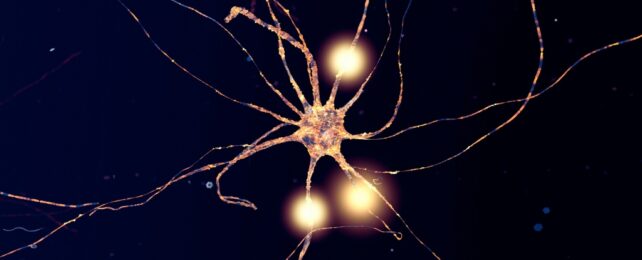A first-of-its-kind study reveals that damaged mitochondrial DNA sets off a chain reaction that can spread Parkinson's disease to other parts of the brain in a similar way to an infection.
Mitochondria – tiny organelles in our cells that produce energy – contain a DNA bank of their very own, separate from the chromosomes in the cell's nucleus.
Damaged mitochondrial DNA (mtDNA) can activate two proteins involved in the immune system, and researchers found these specific proteins are upregulated in the brains of both humans with Parkinson's disease and mice engineered to model the condition.
The researchers also identified another protein – that plays a key role in spreading damaged mitochondrial DNA to other neurons – which may be a new target for developing treatments to prevent the progression of Parkinson's disease.
The team from Denmark and Germany thinks that blood tests could detect damaged mitochondrial DNA, as early biomarkers for Parkinson's disease.
"For the first time, we can show that mitochondria, the vital energy producers within brain cells, particularly neurons, undergo damage, leading to disruptions in mitochondrial DNA," says biotechnologist Shohreh Issazadeh-Navikas from the University of Copenhagen in Denmark.
"This initiates and spreads the disease like a wildfire through the brain."
In the past, researchers focussed on searching for hereditary factors to explain cases of Parkinson's among family members. Over time it became clear that these factors couldn't explain the majority of patient conditions.
"Our findings establish that the spread of the damaged genetic material, the mitochondrial DNA," Issazadeh-Navikas says, "causes the symptoms reminiscent of Parkinson's disease and its progression to dementia."
The researchers studied postmortem brain samples from people with and without Parkinson's symptoms in order to pinpoint molecular pathways involved in the pathology of the disease.
They found that two proteins, TLR9 and TLR4, are activated in the spread of damaged mtDNA, and these proteins are upregulated in Parkinson's disease patients.
The researchers then used a mouse model of Parkinson's disease with induced mutations in genes that control these pathways, to study the role of mtDNA damage.
These mice had activation of TLR9 and TLR4 signaling in the identified molecular pathways found in humans, and damaged mtDNA that was expelled from neurons. This could then spread to other neurons and cause neurotoxicity.
Parkinson's disease dementia-like behavioral symptoms, such as neuropsychiatric, motor, and cognitive impairments, were also induced in healthy mice when they injected damaged mtDNA into their brains.
"Small fragments of – actually DNA – from the mitochondria are released into the cell," explains Issazadeh-Navikas. "When these fragments of damaged DNA are misplaced, they become toxic to the cell, prompting nerve cells to expel this toxic mitochondrial DNA."
Neuron damage in healthy mice happened in areas far from the injection site, too. It appears the damaged mtDNA causes the spread of Parkinson's disease dementia traits in a way that is similar to how viruses spread.
With further analysis, the researchers discovered that a protein known as Rps3 helps TLR4 to recognize damaged mtDNA and helps expel toxic fragments from neurons.
"Given the interconnected nature of brain cells, these toxic DNA fragments spread to neighboring and distant cells, similar to an uncontrolled forest fire sparked by a casual bonfire," Issazadeh-Navikas says.
"It could be possible that the damage of the mitochondrial DNA in the brain cells leaks from the brain into the blood."
The team's ongoing research aims to investigate mitochondrial DNA damage detection in the blood as a predictor of disease progression in the hope of bringing us one step closer to understanding how Parkinson's develops in the brain and progresses into dementia.
"These insights may pave the way for innovative treatment strategies and monitoring approaches for Parkinson's disease," the authors write.
The study has been published in Molecular Psychiatry.
